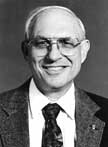by Lee C. Gerhard,
Director and State Geologist

A
century ago, geologists focused on resource exploration and fundamental
investigation of the geological history of the earth. Today, they continue
to be expert providers of resources. But they also have a fundamental
body of knowledge about earth environments and sustainability of the human
population. New technology has made it easier to study the earth and has
dramatically increased the volume of earth resources available to sustain
society. The entertainment industry has provided us with access to the
minds of children through movies such as “Jurassic Park,”
repopularizing dinosaurs and geology. Television has helped show how exploration
geologists practice their profession.
This issue of The Geologic Record illustrates all of these trends.
New technology is featured in the use of carbon dioxide as a resource-recovery
tool in older oil fields, perhaps creating an additional billion barrels
of oil to be recovered in Kansas, not counting other midcontinent oil
fields. Although the technology has been used in deeper fields, our proposed
pilot project would be the first application to midcontinent reservoirs.
The Geology Extension program, which communicates geological knowledge
to the public, has been a great success and continues to build. Scientists
have special knowledge that must be shared with the public. Sometimes
it is difficult to communicate that knowledge, because popular perception
of issues differs from the science. The KGS Geology Extension program
is designed to provide geological information in forms that people can
use, while avoiding issues of political perceptions.
When I was very young, photographs and books about Dr. Roy Chapman Andrew’s
American Museum of Natural History expeditions to Mongolia to collect
dinosaurs, his discovery of dinosaur eggs, and his writings stimulated
my interest in natural science. In my high school yearbook, the class
prophesy was that I would end up in the Gobi desert collecting fossils.
I haven’t made it there yet, but those early readings and photographs
were the reason I became interested in geology. The opening of the new
Sternberg Museum in Hays, with its classic western Kansas marine vertebrate
fossils and other exhibits, is cause for celebration. We hope that exhibits
of dinosaurs from the KU Museum of Natural History will follow, creating
a major tourist and educational trek through Kansas. The Survey is currently
sponsoring a Kansas vertebrate fossil “dig” by Prof. Larry
Martin.
The Geologic Record has allowed us to share these and other stories of geology. Thanks to all of you who have read and commented on my columns. It’s been fun.

In July 1999, Lee Gerhard is stepping down after 12 years as state geologist and director of the Kansas Geological Survey. He will remain at the Survey as principal geologist.
GeoKansas—
A Place to Learn about Kansas Geology
Need
information about the state’s rocks and minerals or just a good
place to see geologic features? Then take a look at the Survey’s
new web site, GeoKansas.
Organized by different regions within Kansas, such as the High Plains,
Flint Hills, and Osage Cuestas, GeoKansas provides
basic information about geologic history, the kinds of rocks and minerals
you’re likely to encounter, and places to go to get a closer look
at geology. Numerous images highlight the state’s geologic diversity,
and the online glossary gives visitors help with unfamiliar terms.
GeoKansas is one of the outreach projects of the Survey’s Geology Extension program. It went online on April 1, 1999, and received over 2,200 hits the first month. Information on other topics—such as fossils, water quality, water quantity, and geologic hazards—will be added in the future, making GeoKansas the place to continue to learn about Kansas geology.
Online February 10, 2003
Comments to: lbrosius@kgs.ku.edu
Kansas Geological Survey
URL:http://www.kgs.ku.edu/Publications/GeoRecord/1999/vol5.2/Page2.html